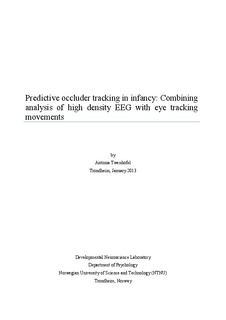| dc.contributor.advisor | Meer, Audrey van der | nb_NO |
| dc.contributor.author | Twenhöfel, Antonia | nb_NO |
| dc.date.accessioned | 2014-12-19T14:42:45Z | |
| dc.date.available | 2014-12-19T14:42:45Z | |
| dc.date.created | 2013-03-18 | nb_NO |
| dc.date.issued | 2013 | nb_NO |
| dc.identifier | 611643 | nb_NO |
| dc.identifier.uri | http://hdl.handle.net/11250/270981 | |
| dc.description.abstract | An essential function of the human visual system is to perceive natural scenes as coherent even if objects are temporarily out of sight due to eye saccades or object occlusion. While a great deal of behavioural studies investigated the emerging ability of object permanence during infancy, little is known about the development of mediating neural structures. In the present study responses to a moving stimulus over a brief occlusion are investigated in 4/5-month-old-infants and 11/12-month-old infants by combining measurements of eye movements with analysis of neuronal gamma oscillations, commonly known as correlates of object processing and perception. Recordings of gamma activity were obtained via highdensity electroencephalogram (EEG). With age, infants showed more instances of shifting gaze predictively over the occluder, which was accompanied with a shift of neuronal gamma oscillations from occipital areas in the dorsal stream to anterior temporal areas in the ventral stream. This shift in activity in neuronal regions suggests different strategies of occluder tracking between the two age groups, where the younger infants appear to let themselves mainly be guided by spatio-temporal information processed in the dorsal pathway, whereas ventral pathway activation observed in the older infants suggests that 11/12-month-old infants take object identity into account for individuation processes. | nb_NO |
| dc.language | eng | nb_NO |
| dc.publisher | Norges teknisk-naturvitenskapelige universitet, Fakultet for samfunnsvitenskap og teknologiledelse, Psykologisk institutt | nb_NO |
| dc.subject | Social and Behavioural Science, Law | en_GB |
| dc.title | Predictive occluder tracking in infancy: Combining analysis of high density EEG with eye tracking movements | nb_NO |
| dc.type | Master thesis | nb_NO |
| dc.source.pagenumber | 36 | nb_NO |
| dc.contributor.department | Norges teknisk-naturvitenskapelige universitet, Fakultet for samfunnsvitenskap og teknologiledelse, Psykologisk institutt | nb_NO |
